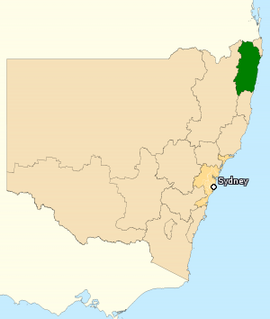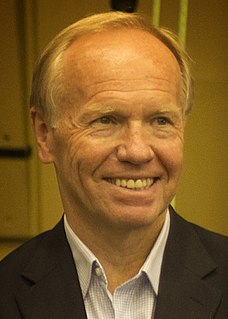Related Research Articles

The Division of Page is an Australian electoral division in the state of New South Wales. It is located in the far north-east of the state, adjoining the border with Queensland and the Tasman Sea. The division is named after the Right Honourable Sir Earle Page, the second leader of the Country Party of Australia and the Prime Minister of Australia after the death of Joseph Lyons in 1939. The division was proclaimed at the redistribution of 11 October 1984, and was first contested at the 1984 federal election.

An election was held in the Australian state of Queensland on 9 September 2006 to elect the 89 members of the state's Legislative Assembly, after being announced by Premier Peter Beattie on 15 August 2006.
The following pendulum is known as the Mackerras Pendulum, invented by psephologist Malcolm Mackerras. Designed for the outcome of the 2007 federal election, the pendulum works by lining up all of the seats held in Parliament, 83 Labor, 55 Liberal, 10 National, and 2 independent, according to the percentage point margin on a two candidate preferred basis, as elected in 2007. The two candidate result is also known as the swing required for the seat to change hands. Given a uniform swing to the opposition or government parties in an election, the number of seats that change hands can be predicted. Swing is never uniform, but in practice variations of swing among the Australian states usually tend to cancel each other out. Seats are arranged in safeness categories according to the Australian Electoral Commission's classification of safeness. "Safe" seats require a swing of over 10 per cent to change, "fairly safe" seats require a swing of between 6 and 10 per cent, while "marginal" seats require a swing of less than 6 per cent.
The following pendulum is known as the Mackerras Pendulum, invented by psephologist Malcolm Mackerras. Designed for the outcome of the 2010 federal election, the pendulum works by lining up all of the seats held in Parliament, 72 Labor, 72 Coalition, 1 Nationals WA, 1 Green and 4 independent, according to the percentage point margin on a two candidate preferred basis. The two party result is also known as the swing required for the seat to change hands. Given a uniform swing to the opposition or government parties in an election, the number of seats that change hands can be predicted. Swing is never uniform, but in practice variations of swing among the Australian states usually tend to cancel each other out. Seats are arranged in safeness categories according to the Australian Electoral Commission's classification of safeness. "Safe" seats require a swing of over 10 per cent to change, "fairly safe" seats require a swing of between 6 and 10 per cent, while "marginal" seats require a swing of less than 6 per cent.
The following is a Mackerras pendulum for the Victorian state election, 2006.
The following pendulum is known as the Mackerras Pendulum, invented by psephologist Malcolm Mackerras. Designed for the outcome of the 2010 Victorian state election, the pendulum works by lining up all of the seats held in Parliament, according to the percentage point margin on a two candidate preferred basis. The two party result is also known as the swing required for the seat to change hands. Given a uniform swing to the opposition or government parties in an election, the number of seats that change hands can be predicted. Swing is never uniform, but in practice variations of swings usually tend to cancel each other out. "Safe" seats require a swing of over 10 per cent to change, "fairly safe" seats require a swing of between 6 and 10 per cent, while "marginal" seats require a swing of less than 6 per cent.
The following is a Mackerras pendulum for the Queensland state election, 2009.
The following is a pendulum based on the outcome of the 2010 federal election and changes since, including the redistributions of seats in South Australia and Victoria. It is a Mackerras Pendulum, invented by psephologist Malcolm Mackerras, which works by lining up all of the seats held in Parliament according to the percentage point margin on a two-candidate-preferred basis. The two-party result is also known as the swing required for the seat to change hands. Given a uniform swing to the opposition or government parties in an election, the number of seats that change hands can be predicted. Swings are never uniform, but in practice variations of swing among the Australian states usually tend to cancel each other out. Seats are arranged in safeness categories according to the Australian Electoral Commission's (AEC) classification of safeness. "Safe" seats require a swing of over 10 per cent to change, "fairly safe" seats require a swing of between 6 and 10 per cent, while "marginal" seats require a swing of less than 6 per cent. The swings for South Australian and Victorian seats are notional, based on calculations by the AEC.
The following is a Mackerras pendulum for the Victorian state election, 2002.
The following is a Mackerras pendulum for the Victorian state election, 1999.
The following is a Mackerras pendulum for the Victorian state election, 1992.
The following is a Mackerras pendulum for the Victorian state election, 1996.
At the 2016 federal election of the 150 House of Representatives seats the Liberal/National Coalition won 76, a one-seat majority, Labor won 69 seats and crossbenchers won the remaining five. A redistribution in 2017/18 changed the representation entitlements. For the next election, the number of seats in the House will increase to 151, South Australia will lose a seat, Victoria and the Australian Capital Territory (ACT) will gain one seat each.
The following pendulum is known as the Mackerras Pendulum, invented by psephologist Malcolm Mackerras. Based upon the outcome of the 2007 federal election and changes before the 2010 election, the pendulum works by lining up all of the seats held in Parliament, 83 Labor, 55 Liberal, 9 National, and 3 independent, according to the percentage point margin on a two party preferred basis.
The following is a Mackerras pendulum for the upcoming Victorian state election, 2014.
The following is a Mackerras pendulum prior to the Queensland state election, 2015.
The following is a Mackerras pendulum for the New South Wales state election, 2015.
This is a Mackerras pendulum for the 2016 Australian federal election.
The following is a Mackerras pendulum prior to the Queensland state election, 2017.
The following is a Mackerras pendulum for the Queensland state election, 2017.
References
- ↑ Green, Antony. "Final Queensland Election Results, Preferences and a New Pendulum". Antony Green's Election Blog. ABC. Archived from the original on 17 February 2015. Retrieved 18 February 2015.